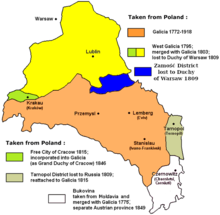Zamoscer Circle
Zamoscer district ( Polish cyrykuł zamojski ) was a district in the Kingdom of Galicia and Lodomeria in the years 1783-1809 with the seat in Zamość . The district comprised the northernmost part of the land of the First Polish Division on the border with Poland in the north, from 1795 western Galicia . It had an area of over 5000 km² (over 6% of the territory of the first partition of Poland). The area coincided more or less with today's landscape Zamojszczyzna or with the Zamość Voivodeship in the years 1975-1998, today with the southeastern part of the Lublin Voivodeship . It was ceded to the Duchy of Warsaw after the Peace of Schönbrunn in 1809 with Western and New Galicia .
history
The area covered part of the Polish Chełmer Land of the Ruthenian Voivodeship and part of the Bełz Voivodeship with Tomaszów and Hrubieszów . The Habsburgs initially treated the conquered area as a temporary acquisition and took over the Polish administration of the voivodeships. It was not until 1773 that the first provisional administrative subdivisions were introduced. At that time it was divided into eight district districts (the exact extent of which is unknown) as the Bełz District with its seat in the more developed Zamość. There was a lack of civil servants, most of whom came from Austria and Bohemia. In 1775 the number of district districts was reduced to three: Zamość, Sokal and Tomaszów.
After the death of Maria Theresa, the Josephine reforms brought about a longer-term administrative division. The county districts were abolished. The new Zamosc district was larger than the district Zamość and included the area from Tomaszów and Krzeszów on the San in the southwest to the Bug in the northeast.
According to the principles of enlightened absolutism, the district administration had very great powers, even in everyday life. After Joseph II's patent from December 1785, the German language became the only official language, also in the village communities, whose jurisdiction was expanded. The distinction between localities with city rights became clearer than in Poland: the cities with full rights were run by magistrates headed by mayors. Under Joseph II, the administration strove to deurbanize the smaller towns in particular, in order to bring them under the aristocratic jurisdiction of assesors or syndics as mere market places .
1783 there were 10 cities ( Grabowiec , Horodło , Hrubieszów, Józefów , Krzeszów, Szczebrzeszyn , Tarnogród , Tomaszów, Tyszowce and Zamość) and 7 market town ( Jarczów , Komarów , Krasnobród , Krylov , Łaszczów , Skierbieszów and Uchanie ).
Maria Theresa had the first craftsmen from German-speaking areas settle in Zamość as early as 1774. Some German colonies also emerged in the course of the Josephine colonization (e.g. over 90 families in 9 localities of the Zamość Family Fideikommiss ). A road from Zamość to Lemberg (around 130 km southeast) was laid out.
The whole district was ceded to the Duchy of Warsaw on October 14, 1809 as the only district of the First Partition of Poland. The southern border of the district became the new border of the Habsburg Monarchy, from 1815 to Congress Poland . The area belonged to the Lublin department in the Duchy of Warsaw and was divided into four powiate: Hrubieszów, Tarnogród, Tomaszów and Zamość. The market places were upgraded to cities again.
literature
- Geografia albo dokładne opisanie Królestwa Galicji i Lodomerii . 1786, Zamojski cyrkuł, p. 44–50 (Polish, online [PDF]).
- J. Feduszka: Zmiany przebiegu granicy , 2001 (Polish)
Individual evidence
- ^ Map of the historical landscapes in the Lublin Voivodeship
- ↑ Ryszard Orłowski: Koloniści rolnicy w Ordynacji Zamojskiej w koncu XVIII wieku , 1957 (Polish)
- ↑ Katarzyna Wójcik: Mniejszość niemiecka na Lubelszczyźnie w latach 1914-1918 , Chełm, 2007 (Polish)



